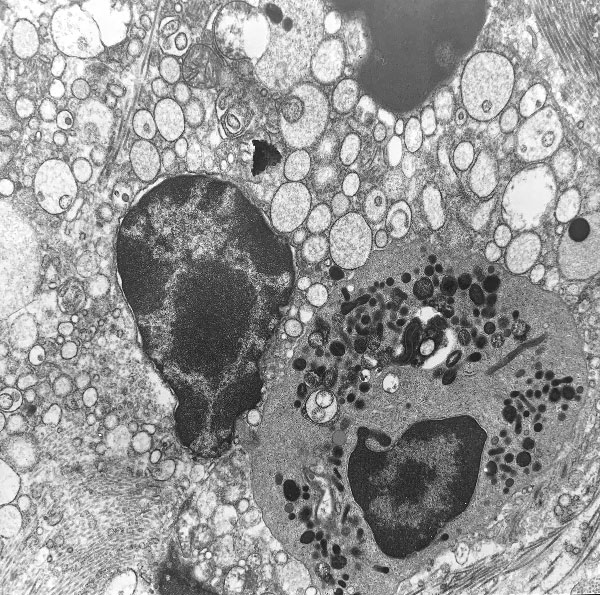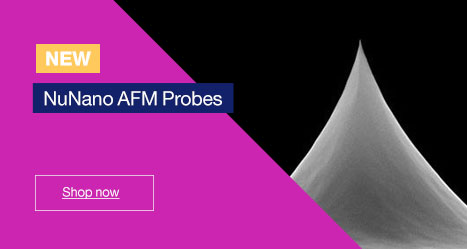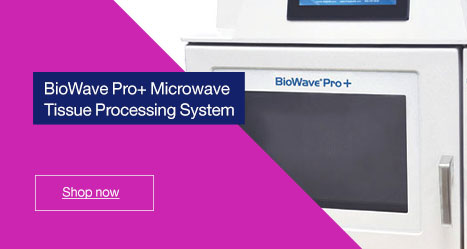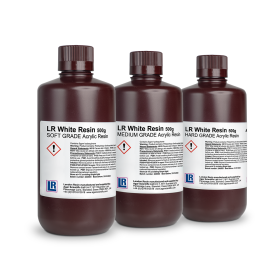
PMN Phagocytosis of Spirochaetes in connective tissue in Juvenile Periodontitis
When using LR White embedding resin for electron microscopy, very few changes need to be made to the regime used for epoxy resin embedding. Every laboratory has its own individual embedding schedule, but we have laid out a “typical” schedule in this blog post for LR White as guidance for its use.
Fixation
No change from normal fixation should be made if EM analysis is only required from the final blocks. However, if good ultrastructure and a wide range of LM staining is required then we have found that the use of aqueous paraformaldehyde in a phosphate buffer pH 7.2 with 2.5% w/v sucrose is the best compromise. Glutaraldehyde alone and Karnovsky’s glutaraldehyde-formaldehyde mixtures may need to patchy LM staining and some stains not working or giving “false positives” (e.g. PAS) whereas normal formalin fixation yields unacceptable EM ultrastructure.
For dual LM/EM applications, Osmium Tetroxide should be avoided due to its effect on many LM stains but 1% phospho tungsten acid (w/v) in the first absolute ethanol step of dehydration improves electron contrast without adversely affecting most LM stains. Osmium Tetroxide may be used if the blocks are required for electron microscopy only.
Dehydration
A graded ethanol series is the method of choice when embedding in LR White. Acetone acts as a radical scavenger in the resin system and therefore traces of acetone left in the tissue at curing can interfere with this polymerisation. For this reason, the use of graded acetone series and dimethoxypropane (which generates acetone) are best avoided. If the use of dimethoxypropane is considered vital we recommend either a protracted resin infiltration or washing the tissue with dry ethanol prior to infiltration in order to minimise the chance of acetone contamination of the final resin.
Infiltration
The extremely low viscosity of LR White may be exploited by allowing the use of short infiltration times or large specimens – but not both! A 1mm cube of animal tissue will be adequately infiltrated in about 3 hours if 4-6 changes of LR White at 60°C are employed during this period.
An overnight infiltration at room temperature, followed by two short changes of resin will often be more convenient, however, the long shelf life and low extraction rate of LR White allows specimens (e.g. reserve tissue) to be stored safely in resin for many weeks at 4°C if required. Larger blocks do require significantly longer infiltration times compared to small blocks.
Polymerisation
Samples stained with Osmium Tetroxide should not be “cold-cured” with the accelerator. This process is strongly exothermic, and the dark colour of the tissue leads to a focal heat accumulation which can cause local problems in and around the tissue.
If the issue is not fixed with Osmium Tetroxide then curing with LR White accelerator may be employed. As with curing blocks for light microscopy we recommend cooling the moulds during polymerisation, but there is no need to exclude oxygen from the surface of the curing block.
Thermal curing should be used for osmicated specimens and may be used for all specimens. Here it is important to limit the contact of oxygen with the resin while polymerisation occurs. The most convenient way of achieving this with capsule-type embedding is to use gelatin capsules (available from our website), fill up to the brim and slide the other half of the capsule on.
If flat embedding is required for cutting orientation then the surface of the resin must be covered to prevent contact with oxygen.
One convenient method is to utilise the JB-4-type moulds and chucks, useful for light microscopy, and after polymerisation may be sawn off the stub and mould re-used.
Polymerisation time and temperature are fundamental to the physical characteristics of the final block to a much higher degree than with undercured epoxy systems.
We strongly recommend a temperature of 60°C +2 for a period of 20-24 hours. Some ovens are not capable of controlling polymerisation temperature so closely, and if faced with over brittle blocks, this is the first parameter to check.
LR White has extremely good powers of penetration and can penetrate and soften some low-density polyethylene capsules, which causes them to distort and collapse. Also, polyethylene is not impermeable to oxygen and may allow enough contact with atmospheric oxygen to give the blocks an inhibited “tacky” surface.
Both these problems may be overcome by the use of gelatin capsules (size 00 is similar to the popular polyethylene capsule size) and these are much cheaper and easier to seal during polymerisation.
Resin may be used straight from the refrigerator and has a very low toxicity both in monomeric and polymerised state, unlike epoxies. The cold cure accelerator does have some toxic risk and contact with the skin and eyes should be avoided.
For cold curing the accelerator should be used at one drop per 10ml of resin and this should cause polymerisation in between 10 and 20 minutes. If polymerisation occurs faster than this, we recommend either more careful metering of the one drop of accelerator or a higher volume of resin per drop of accelerator.
Trimming and cutting
Trimming the block may be done with a jewellers saw, razor blade or with a glass knife on the ultramicrutome as with epoxy resin blocks. Cutting mayo be performed in the same way as for epoxy resin with glass or diamond knives. A typical cutting speed of about 1mm per second is suitable.
Section staining
All the common section stains give good results on tissue embedded in LR White resin. Stains made up in ethanol or methanol should be avoided as these solvents soften the resin and may remove sections from grids. As an alternative to Uranyl Acetate, 1% phosphotungstic acid has proved a good general-purpose stain, both as a block stain, as mentioned earlier, and as a section stain.
In the Electron Microscope
An initial reduction in electron density may accompany the initial exposure of the resin to the beam. This is thought to represent a loss of water, imbibed from knife-boat or staining solutions. Thinning as such does not occur and specimens have been kept stationary under a 120kV electron beam for 3 hours with no obvious signs of damage.
For more information, visit www.agarscientific.com/londonresin



